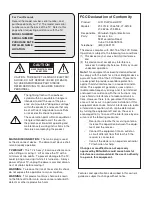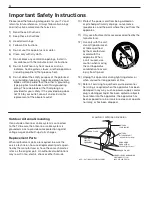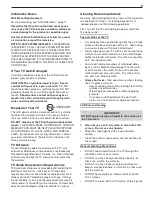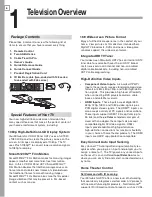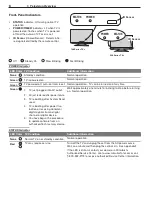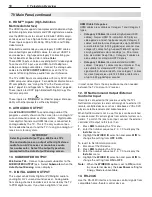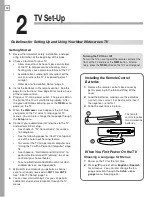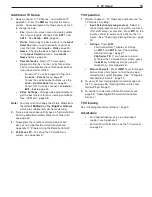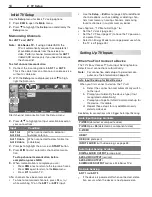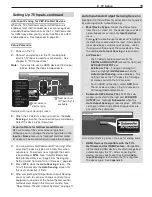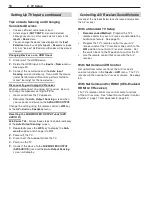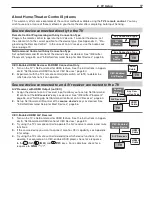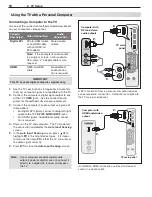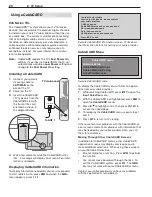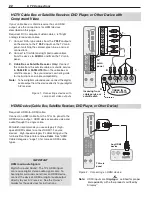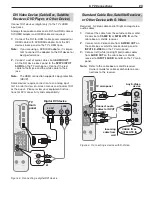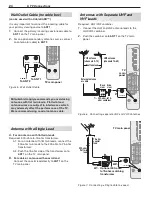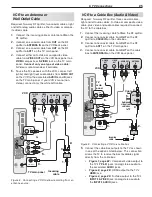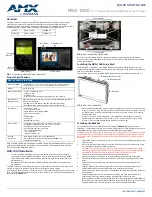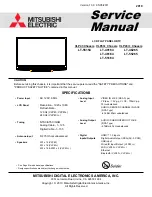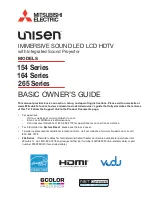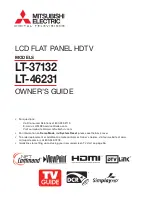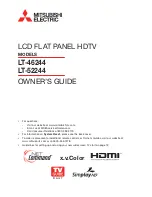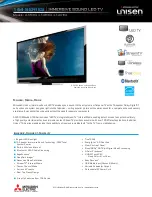
10
1. Television Overview
TV Main Panel, continued
8. HDMI™ Inputs (High-Definition
Multimedia Interface)
The HDMI inputs support uncompressed standard and high-
definition digital video formats and PCM digital stereo audio.
Use the HDMI inputs to connect to CEA-861 HDMI compli-
ant devices such as a high-definition receiver or DVD player.
These inputs support 480i, 480p, 720p, 1080i, and 1080p
video formats.
Mitsubishi recommends you use category 2 HDMI cables,
also called high-speed HDMI cables, to connect HDMI 1.3
source devices. High-speed category 2 cables bring you
the full benefits of Deep Color and
x.v.Color
.
These HDMI inputs can also accept digital DVI video signals.
To connect a DVI input, use an HDMI-to-DVI adapter or
cable plus analog audio cables. Connect the analog audio
cables to the
DVI/PC INPUT AUDIO
jacks on the TV to
receive left and right stereo audio from your DVI device.
The TV’s HDMI inputs are compatible with many DVI-D and
HDMI computer video signals. For additional information on
PC compatibility, see “Using the TV with a Personal Com-
puter,” page 18, and Appendix A, “Specifications,” page 66.
These inputs are HDCP (High-Bandwidth Digital Copy Pro-
tection) compliant.
These inputs are
certified for proper interoper-
ability with other products certified by Simplay
™
.
9. AVR AUDIO OUTPUT
Use
AVR AUDIO OUTPUT
to send analog audio of the
program currently shown on the screen to an analog A/V
surround sound receiver or stereo system. Digital audio
from digital channels and HDMI devices is converted to
analog audio by the TV. This is the only audio connec-
tion needed between it and the TV if using an analog A/V
receiver or stereo system.
IMPORTANT
Selecting Audio Output Type, 246 Series TVs
The red audio jack can output either right stereo
audio for an A/V receiver or mono bass audio
for a subwoofer. Select the output type when
prompted in the
Auto Output Sensing
screen.
10. SUBWOOFER OUTPUT
246 Series TVs.
Connect a powered subwoofer to the
SUBWOOFER OUTPUT
jack. Select
Subwoofer
when the
Auto Output Sensing
screen displays.
11. DIGITAL AUDIO OUTPUT
This output sends Dolby Digital or PCM digital audio to
your digital A/V surround sound receiver. Analog audio
from analog channels and devices is converted by the TV
to PCM digital audio. If you have a digital A/V receiver,
in most cases this is the only audio connection needed
between the TV and your A/V receiver.
12. IR NetCommand Output/External
Controller Input
IR emitters connected to this jack are used by the TV’s
NetCommand system to send control signals to external IR
remote-controlled devices such as cable boxes, VCRs, DVD
players, satellite receivers and audio receivers.
When NetCommand is not in use, this jack can be switched
to receive wired IR control signals from external system con-
trollers. To switch this jack to an input, connect the external
controller’s IR output to this jack, then:
Press
1.
MENU
to display the TV menu.
Enter the number sequence 2, 4, 7, 0 to display the
2.
Installer
menu.
Highlight the
3.
WIRED IR
selection and press
ENTER
to
change the setting from
OFF
to
ON
.
To revert to NetCommand control:
Disconnect the IR device.
1.
Press
2.
MENU
to display the TV menu.
Enter the number sequence 2, 4, 7, 0 to display the
3.
Installer
menu.
Highlight the
4.
WIRED IR
selection and press
ENTER
to
change the setting from
ON
to
OFF
.
Note:
When the
WIRED IR
option is set to
ON
(control
by an external device), the
Low Power
setting for
Energy Mode is unavailable.
13. RS-232C
Use the RS-232C interface to receive control signals from
compatible home-theater control devices.
HDMI Cable Categories
HDMI cables are available as Category 1 and Category 2
types.
Category 2 Cables
•
(also called high-speed HDMI
cables). Newer, HDMI 1.3-compliant DVD players,
video games, and set-top boxes require Category 2
cables, suitable for clock frequencies up to 340 MHz
or data rates of up to 10.2 gigabits per second. Use
category 2 cables for high-speed 1080p HD signals
carrying extended color encodings (i.e., 30 or more
bits, also called Deep Color). Category 2 cables are
also suitable for standard HDTV signals.
Category 1 Cables
•
(also called standard HDMI
cables). Category 1 cables may be unmarked. They
are suitable for standard HDTV 720p and 1080i
signals with 8-bit color depth. Use category 1 cables
for clock frequencies up to 74.25 MHz or data rates
of up to 2.23 gigabits per second.


